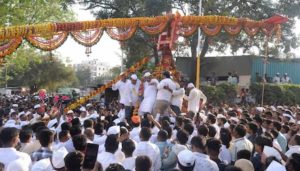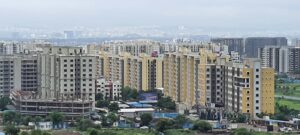Tiananmen Square Massacre: A Grim Reminder of China’s Repression

By Kartik Lokhande
Much has transpired in the world since the ruthless crackdown on pro-democracy demonstrators at Tiananmen Square by Communist China on June 3-4, 1989. While the citizens of China strive to keep the spirit of the “Goddess of Democracy” alive, the authoritarian regime has relentlessly tightened its grip on public life, attempting to enforce collective amnesia. However, recent events in China reveal that the people have not forgotten the Tiananmen Square massacre. The facts written in blood have proven resistant to the lies penned in ink.
June 3-4, 1989, remains etched in the collective memory of the world as days of unimaginable violence in Communist China. During these fateful days, the Chinese government unleashed tanks and opened fire on its own people, mostly students, to suppress the 50-day-long pro-democracy protests. The events that unfolded during that spring and early summer continue to haunt China to this day. For Chinese people worldwide, the anniversary of the Tiananmen Square massacre serves as a reminder to renew their commitment to the cause of democracy in the face of authoritarian rule in China.
The massacre at Tiananmen Square, which successive Chinese authorities have tried to downplay as a mere “incident,” marked the culmination of pro-democracy protests ignited by the death of liberal leader Hu Yaobang on April 15, 1989. Hu Yaobang had served as the General Secretary of the Chinese Communist Party (CCP) from 1982-1987 until he was forced to resign due to his views that clashed with those of the influential figure Deng Xiaoping. To understand the significance of these events, we must briefly revisit 1984-85 when concerns arose amidst China’s positive economic outlook.
Vijay Gokhale, former Ambassador of India to China and an eyewitness to the Tiananmen Square protests, provides a vivid account of the situation in his insightful book, “Tiananmen Square: The Making of a Protest.” He describes how even a single individual’s protest in October 2022, known as the “Sitong Bridge protest,” led to strict monitoring of the sale of white cloth in Beijing. The lone protester’s banner conveyed powerful sentiments: “We want food, not PCR tests. We want freedom, not lockdowns. We want respect, not lies. We want reform, not a Cultural Revolution. We want a vote, not a leader. We want to be citizens, not slaves.”
This call for change resonated throughout China and within the Chinese diaspora. Even the walls of public bathrooms in Sichuan bore graffiti that read, “The spirit of 8964 will never be snuffed out.” Here, “8964” symbolizes the date of the Tiananmen Square massacre, with “89” representing the year 1989, “6” denoting the month of June, and “4” signifying the date of China’s brutal crackdown on the pro-democracy protesters.
Despite the authoritarian regime’s relentless efforts to suppress dissent through censorship, surveillance, arbitrary detentions, and attempts to erase the memories of 1989 from the public consciousness, the spirit of pro-democracy remains alive in China. The CCP persistently portrays the 1989 massacre as a mere “incident” while justifying its actions.
In an editorial titled ‘1989 incident provides Chinese people immunity from color revolutions,’ published on June 4, 2021, The Global Times expressed the belief that the events of the Tiananmen Square massacre have immunized the Chinese people against being misled by political movements. Despite facing a ‘color revolution,’ China remained resilient, thanks to the leadership of the Communist Party, which saved the nation from a critical situation.
The Tiananmen Square massacre was a dark moment in China’s modern history, reminiscent of past incidents. Lu Xun, a renowned Chinese author, foresaw the possibility of such events reoccurring when he wrote about armed police opening fire on protesters in Tiananmen Square in 1926 to suppress opposition to warlord Zhang Zuolin’s acceptance of Japanese demands. Lu Xun prophetically stated, “This is not the end of an incident, but a new beginning. Lies written in ink can never conceal facts written in blood. Blood debts must be repaid in kind, with interest increasing over time.”
After the 1989 Tiananmen Square massacre, students in Chengdu expressed their frustration by writing the phrase ‘All blood debts must be repaid in blood’ on sheets. The book ‘The Tiananmen Papers,’ published 12 years later, highlights the persistent demand for peaceful expression from the Chinese people. As China develops, dissenters both within and outside the regime will continue to seek avenues for their voices to be heard. If existing channels within the system are inadequate, they will seek alternative means. The pressures between society and the regime, as well as within the regime itself, cannot be resolved without addressing the demands raised more than a decade ago in Tiananmen Square.
Recent events in China seem to echo this sentiment within Chinese society. Louisa Lim’s book, ‘The People’s Republic of Amnesia: Tiananmen Revisited,’ published in 2014, poignantly summarizes the situation in China in relation to the Tiananmen Square incident. She argues that the violent suppression of the 1989 movement was not an isolated incident but part of a pattern that stretches back to the May 4th Movement in 1919, the Tiananmen killings of 1926, the repression of mourning protests after Zhou Enlai’s death in 1976, and the failed student movement of 1986-1987. Chinese history seems to repeat itself in an endless cycle of shattered hopes, persisting from one generation to the next, fueled by a tendency to embrace forgetfulness.








